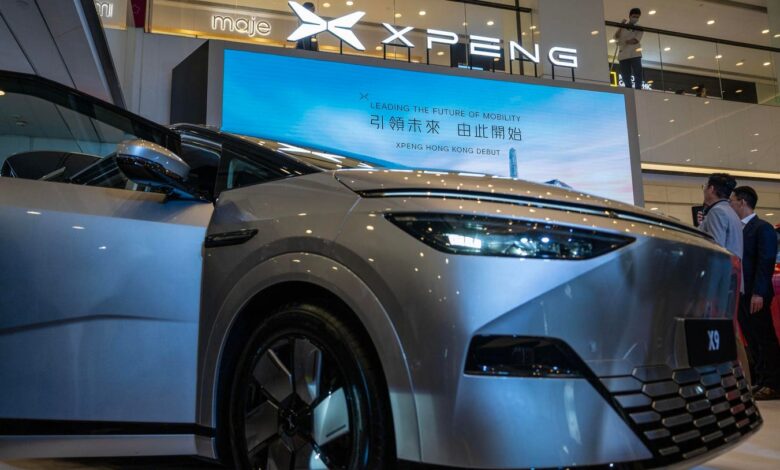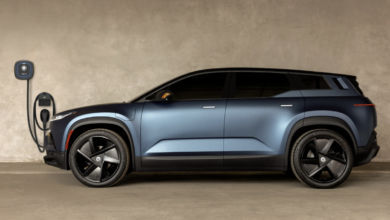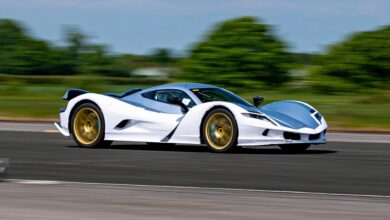With Stock Down 40% This Year, Can Xpeng’s Premium X9 And New Budget Brand Drive A Recovery?

A general view is showing the Xpeng X9 during the Xpeng debut ceremony in Hong Kong, China, on May … [+]
Chinese luxury electric vehicle maker Xpeng stock has seen its stock decline by about 43% year-to-date. This compares to rival Nio stock, which is down by 29% over the same period. However, Xpeng’s delivery performance appears to be looking up. For the month of May, the company delivered 10,146 vehicles, rising by about 35% year-over-year and by close to 8% compared to April. This takes the company’s year-to-date unit sales to 41,360 vehicles, up 26% year-over-year. Xpeng has been benefiting from the ramp-up of sales of the premium X9 multi-purpose vehicle which was launched in early January. However, Xpeng’s deliveries were weaker than rival Nio which sold a solid 20,544 vehicles for the month, representing an increase of 234% year-over-year and a growth of 31% from April. In comparison Li Auto delivered 35,020 vehicles for the month, up 23.8% year over year.
XPEV stock has suffered a sharp decline of 80% from levels of $45 in early January 2021 to around $8 now, vs. an increase of about 40% for the S&P 500 over this roughly 3-year period. However, the decrease in XPEV stock has not been consistent. Returns were 18% in 2021, -80% in 2022, and 47% in 2023. In contrast, returns for the S&P 500 have been 27% in 2021, -19% in 2022, and 24% in 2023 – indicating that XPEV underperformed the S&P in 2021 and 2022. In fact, consistently beating the S&P 500 – in good times and bad – has been difficult over recent years for individual stocks.
In contrast, the Trefis High Quality Portfolio, with a collection of 30 stocks, has outperformed the S&P 500 each year over the same period. Why is that? As a group, HQ Portfolio stocks provided better returns with less risk versus the benchmark index; less of a roller-coaster ride as evident in HQ Portfolio performance metrics. Given the current uncertain macroeconomic environment with elevated interest rates and an uncertain EV demand picture, could XPEV face a similar situation as it did in 2021 and 2022 and underperform the S&P over the next 12 months – or will it see a recovery?
There are concerns about global EV demand, with most mainstream automakers seeing tepid demand and scaling back on their electrification goals. However, things could be a bit better in China, where the industry sees meaningful government support. China recently announced new incentives of RMB 10,000 (about $1,410) for consumers to trade their older gasoline cars for electric and low-emission vehicles by year-end. Xpeng’s financial metrics have been looking up of late. For Q1 2024, the most recently reported quarter, the company saw average revenue per vehicle rise to about $42,000, up from just about $28,000 in the year-ago quarter. This is largely due to a higher mix of sales of the X9 vehicle which costs over $50,000. Xpeng’s gross margins have also picked up, coming in at 13%, up from under 3% in the year-ago quarter driven by higher sales of technical services following the company’s collaboration with the Volkswagen Group relating to platform and software. Xpeng, which is seen as a leading player in the self-driving software space, is seeing adoption rise quickly. For May, the active user penetration rate of Xpeng’s driving assistance tools in urban driving scenarios reached 84%.
Xpeng also plans to launch more than 10 brand-new models over the next three years, while also partnering with Volkswagen to co-develop VW-branded EVs in a strategic partnership. Xpeng also intends to move beyond the luxury market toward more mass-market models. The company plans to launch its new sub-brand Mona sometime this month, with the vehicles expected to be priced under RMB 150,000 yuan ($21,000), allowing it to compete head-on with the likes of BYD for much bigger volumes in the mass market. See our analysis of Nio, Xpeng & Li Auto: How Do Chinese EV Stocks Compare? for a detailed look at how Xpeng stock compares with its rivals Li Auto and Nio.
XPEV Return Compared With Trefis Reinforced Portfolio
Invest with Trefis Market Beating Portfolios
See all Trefis Price Estimates



